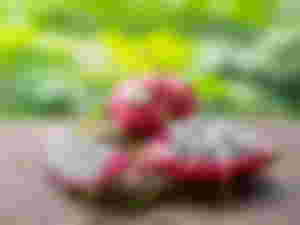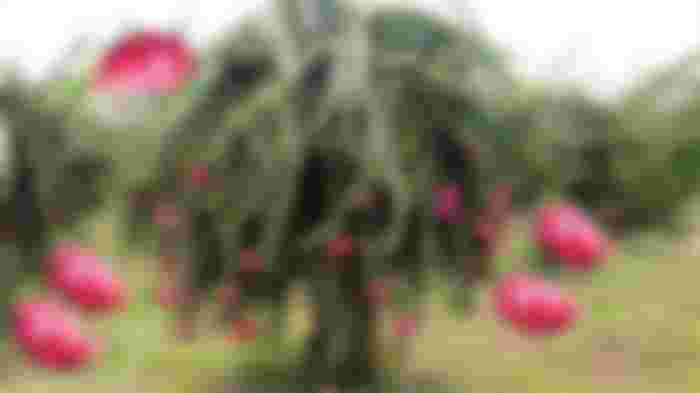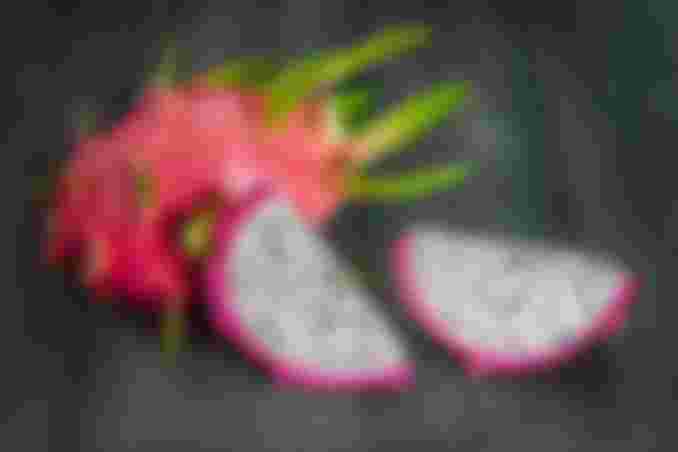
Dr. JC is a fruit of the genus Malacardragon cactus. The dragon fruit tree is like a creeping Euphorbia cactus; But it has no leaves. Seeing the tree, everyone thinks it is an evergreen cactus. Bangladesh Agricultural University Bau Germplasm Center Director Prof. M. A. Rahim first introduced Dragon Fruit in Bangladesh in 2006. Professor. M. A. Rahim brought this fruit variety from Thailand, Florida and Vietnam. Dragon fruit (Hylocereus undatus) originates in Central America. In Vietnam this fruit is mostly cultivated commercially.
Dragon flower queen of the night
The dragon tree blooms at night. It looks a lot like a night queen flower, tall, white and yellow. The dragon flower is called the 'queen of the night'. Flowers self-pollinated; However, pollination of flies, bees and insects accelerates and artificial pollination can also be done.
The fruit of possibility is dragon farming

Dragon fruit likes lots of light. This fruit requires dry tropical weather. Good for fruit at moderate rainfall. With proper rainfall, the flowers fall off and the fruits rot. Dragon fruit can be cultivated in almost all types of soils. However, it is better to cultivate this fruit in high lands where water does not accumulate. High organic matter sandy loam soils are best for cultivating this fruit.
Suitable varieties
Bau Dragon Fruit-1 (white) and Bau Dragon Fruit-2 (red) can be cultivated from Bau Germplasm Center for successful commercial cultivation. Yellow dragon fruit and dark red dragon fruit can also be cultivated.
Planting method

It is better to cultivate the land well with a distance of 3 meters from tree to tree and 3 meters from row to row. However, depending on the situation, the distance can be given more or less.
Fertilizer level and manure management per hole

20-30 days before planting dragon fruit seedlings, 40 kg of decomposed dung, 50 g of urea, 100 g of TSP and MP and 10 g of gypsum, borax and zinc sulphate should be mixed in the soil of the hole. Trees can be planted 20 to 30 days after fertilization. Thereafter, 40 kg of decomposed dung should be applied to the plants every year at the rate of 50 g of urea, 100 g of TSP and MP and 10 g of gypsum, borax and zinc sulphate. Cactus trees can be planted at any time of the year; However, it is better to plant in April-September. 4-5 cuttings are planted in each hole. Cutting seedlings are planted around the pillars and tied to the pillars. In addition, the wheels of small motor vehicles (microbuses, private cars) can be set in the bamboo chagar at the top and the branches of this tree can be easily allowed to grow. The trees are planted in the jungle by making a jungle on a thick wire with two poles.
Attendance
After planting the seedlings, the dragon fruit trees should be tied with poles or pillars. Because the trunk of the dragon tree is creeping in nature. There are three ways to support the tree with poles.
A. Vietnam method,
B. Florida method,
C. Sri Lanka method.
Vietnam method
In this case, cut seedlings have to be planted around the pillar and tied to the pillar.
Florida method
In this method, two poles are buried on both sides and the tree is made into a fence on a thick wire.
Sri Lanka method
In this method, the seedlings are planted by tying the pillars and tied to the pillars. The old tree tires of the motor vehicle were allowed to grow on the bamboo chagars on all four sides of the pillars.
Propagation by cutting
The lineage of dragon fruit is extremely easy to propagate. Seed can also be propagated. It takes a little longer to bear fruit and does not maintain the exact maternal quality. It is better for him to propagate through cutting. The success rate of cutting is almost one hundred percent and the fruit catches quickly. It takes 12-18 months for a tree to produce fruit from cuttings. Seedlings can be easily produced by cutting old and hard branches (1-1.5 feet) and burying the early cut part in sandy-loamy soil in light shade. After 20 to 30 days the roots will come out from the base of the cutting and then the cutting will be suitable for planting in the field. However, according to the suitable environment and need, the cuttings can be planted directly on the main land.
Tree size and pruning
The dragon fruit tree grows very fast and forms a total branch. One year old tree can make up to 30 branches. However, the production of branches depends on the size of the tree. A study has shown that in the context of Bangladesh, a tree bears fruit after 12-16 months. After fruit collection, one or two secondary branches are approved in each of the 40-50 main branches. It is better to cut the tree size and branches in the middle of the day. Any fungicide must be applied after cutting. Otherwise different types of diseases can attack.
Irrigation management
Dragon fruit trees cannot tolerate excess water and it takes very little water to cultivate this fruit. Irrigation in the dry season and drainage in the rainy season must be arranged. In this case, a ditch of 50-100 cm can be made between the two rows. In this way water can be stored in the drain for one or two days and juice can be supplied to the soil of the tree.
Techniques of untimely fruit production
Experimental cultivation at the Bau Germplasm Center has shown that fruits begin to come in June and can be collected until November. In winter, by increasing the length of the day, one 80-100 watt bulb for every four trees is kept burning for 5-6 hours in the evening and the fruit can be brought on time as per the demand.
The new guest is Dragon Fruit
An amateur fruit grower has been cultivating dragon fungus commercially on about 10 acres of land in this country. Rumpa Chakraborty has already started to see the face of success by planting sixteen and a half thousand dragon fruit trees in Marichakata village of Ashulia in Savar, Dhaka. In just one year, those trees have become fruitful. This year he is expecting to get about 8 to 10 thousand fruits. He said that even in Thailand, which is known as the land of dragon fruits, it takes about three years for a tree to become fully fruitful. In Bangladesh, he planted Dragon Fonsut saplings from Thailand in 2009. He himself was quite surprised to see those trees bear fruit in just one year. So he is quite optimistic about the future commercial potential of this exportable fruit. This fruit sapling is now available in the country at the Fruit Germ Plasma Center of Bangladesh Agricultural University. This fruit is also being cultivated commercially in Savar's Jirani. Lutfar Rahman, the proprietor of LR Agro, has developed this garden.
What is the result?
Dragon fruit or dragon fruit is a kind of cactus fruit. Another name for this fruit is Pitaiya. The name of this fruit is Huo Long Guo in China, Thanh Long in Vietnam. Dragon fruit originated in Central America. The fruit was introduced in South Asian Malaysia in the twentieth century. Currently, the fruit is being cultivated more in Vietnam. Apart from Vietnam, cultivation is also taking place in Taiwan, Thailand, Philippines, Sri Lanka, Malaysia, China, Israel and Australia. In 2006, the first dragon fruit tree was brought to Bangladesh. Bangladesh Agricultural University Germ Plasma Center Professor. MA Rahim brought some varieties of dragon fruit from Thailand for research purposes. Those trees are bearing fruit. Based on this success, the Center has now taken steps to expand the cultivation of dragon fruit in remote areas of the country.
Description of the tree
Dragon fruit tree is a kind of cactus. Creeping trees. The tree has no leaves. The trees are 1.5 to 2.5 meters tall. This green tree has very beautiful white and greenish white flowers. The flowers look a lot like ‘Night Queen’. The flowers are fragrant and self-pollinated. The flowers are quite large. The dragon flower is called 'Moon Flower' or 'Queen of the Night'. Flowers form oval fruits. The peel of the fruit is soft. A fruit weighs 150 to 600 grams. Sometimes the weight of the fruit is up to one kg. The flesh of the ripe fruit is quite soft, with numerous black seeds like black cumin seeds, light sweet, very low in calories.
Nutritional value
Out of 100 grams of dragon fruit, 55 grams are edible. Each 100 grams of dragon fruit contains 80 to 90 grams of water, 9 to 14 grams of carbohydrates, 0.15 to 0.5 grams of protein, 0.1 to 0.8 grams of fat, 0.3 to 0.9 grams of fiber, and ash. .4 to 0.8 grams and calories 35 to 50. Also notable among minerals and vitamins are calcium 8-10 mg, iron 0.3-0.8 mg, phosphorus 18-36 mg, niacin 0.2-0.45 mg, vitamin C 4-25 mg, carotene and riboflavin. There are very few. Red shell dragon fruit is high in vitamin C. This fruit is better for diabetic patients than rice. Doctors in Taiwan recommend diabetic patients to eat this fruit instead of rice. Even this fruit lowers the level of cholesterol in the blood and keeps the blood pressure under control. As the shell of this fruit is slippery, it also removes constipation.
Use of fruit
It feels better to keep it in the fins and play it cold. Juice can be made from the fruit. Its flowers are also eaten. The fruit is cut into two slices vertically with a knife for eating. Then the soft shells can be picked up with a spoon and eaten. In addition, the peel can be cut into small pieces and eaten with a fork. Shells with seeds are eaten. Seeds are never digested without chewing. This fruit is not easily digested even if eaten in large quantities. Especially after eating red-shelled dragon fruits, the color of urine also turns red.
Born
Dragon fruit has two types of sour taste and sweet taste. There are three species of sweet-tasting dragon fruit: red dragon fruit or pitaia. The bark of this species is red and the shell is white. The fruits of this species are more common. Costa Rica Dragon Fruit. The color of the peel and shell of this fruit is red. Yellow dragon fruit. The peel of this fruit is yellow and the shell is white.
Stenocereus dragon fruit is sour in taste, these are known as sour dragon fruit or ‘sawar pitaya’. They are found in the arid regions of America. The people of Mexico and America use the juice of the dragon fruit to make various soft drinks and do not eat raw or fresh fruits.
Bau Dragon Fruit-1 and Bau Dragon Fruit-2 can be selected for commercial cultivation. The shell of the first variety is white, the shell of the second variety is red.
Climate and soil
Dragon fruit needs a dry climate. Moderate rainfall is good. However, when it rains more, the flowers fall off and rot occurs. Dragon fruit can be grown on any high ground without waterlogging. Tree growth is good in sun, open space and plenty of organic manure.
Seedlings made
Dragon fruit saplings are very easy to make. Seedlings can be made from seeds. However, it takes a long time for those plants to bear fruit. So it is better to make seedlings by cutting and grafting branches. The old and hard branches are cut one to one and a half feet long and obliquely and if sand or sandy loam is placed in the soil, roots grow from it in 20 to 30 days. However, shade or shade should be provided in the place of cutting. The soil should also have juice. Cutting usually does not die. The cutting tree bears fruit early. Trees produced from cuttings begin to bear fruit within one to one and a half years.
Land preparation and planting
The land can be cultivated well and the seedlings can be planted in rows on three sides in a row. One month before planting, make a hole and fill it with manure. Each hole can be given 40 kg of decomposed dung, 50 g of urea, 100 g of TSP and MOP fertilizer, 10 g of gypsum, zinc sulphate and borax fertilizer. Seedlings can be planted at any time of the year. However, it is better to plant between April and September. Four to five seedlings should be planted in each hole. Trees should be lined with cement or bamboo poles.
Pruning
Dragon fruit grows very quickly. A one-year-old tree can make up to 30 branches. The four-year-old tree produces 130 branches. In this country it starts bearing fruits 12 to 18 months after planting. At the end of fruiting, 1 to 2 branches should be kept in each of 40 to 50 branches of each tree and the rest should be pruned. After pruning, fungicide should be sprayed.
Irrigation
Dragon fruit trees do not require much irrigation. However, when the soil is dry in the dry season, irrigation must be given. There must be a drain between the two rows to get the water out. If the mouths of these drains are blocked and filled with water from time to time, the roots of the trees get water from there. However, it should be noted that this tree can not tolerate excess water. So the land should not be frozen.
Yield
A 12 to 18 month old tree bears 5 to 20 fruits. But an adult tree bears 25 to 100 fruits. Yield per hectare is 20 to 25 tons.
Pest management
No disease or insect attack has been noticed in this new fruit tree. However, sometimes root rot, stem rot and root rot are affected.
The root is rotten
When excess water accumulates at the beginning, root rot occurs. When the tree is pulled, it comes up without roots. For this we have to cultivate in high lands. Where water does not freeze at the beginning.
Stem and root rot disease
The disease is caused by fungi and bacteria. In this case, the disease turns yellow first and then black. Later that part starts to rot and the amount of digestion may increase.



